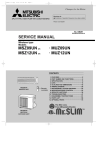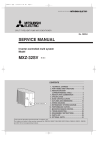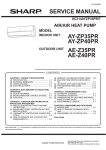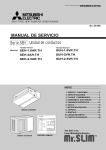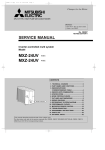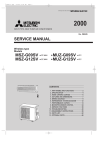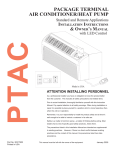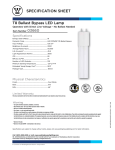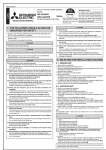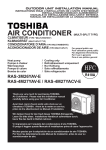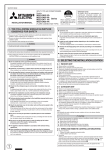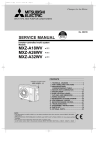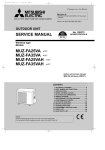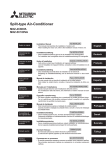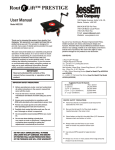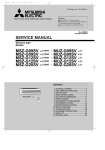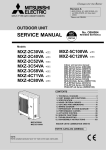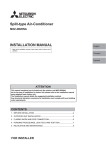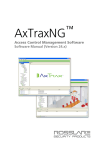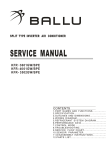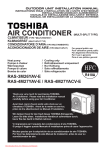Download SERVICE MANUAL MXZ-18TV
Transcript
OB280-1.qxp
01.4.4 2:40 PM
Page 1
SPLIT-TYPE,HEAT PUMP AIR CONDITIONER
No. OB280
SERVICE MANUAL
Inverter-controlled multi system
Model
MXZ-18TV -
E1
CONTENTS
Model indication
1. TECHNICAL CHANGES ····································2
2. PART NAMES AND FUNCTIONS······················2
3. INDOOR/OUTDOOR
CORRESPONDENCE TABLE ···························3
4. INDOOR UNITS COMBINATION ·······················3
5. SPECIFICATION·················································4
6. NOISE CRITERIA CURVES ······························ 5
7. OUTLINES AND DIMENSIONS ························ 6
8. WIRING DIAGRAM ············································7
9. REFRIGERANT SYSTEM DIAGRAM ················8
10. PERFORMANCE CURVES ································9
11. MICROPROCESSOR CONTROL·····················14
12. TROUBLESHOOTING······································19
13. DISASSEMBLY INSTRUCTIONS·····················29
14. PARTS LIST······················································32
15. OPTIONAL PARTS···········································34
This manual describes technical data of outdoor unit.
For the indoor unit refer to the service manuals No. OB229, OB227 REVISED EDITION-B, OB252 REVISED EDITION-A, and OC165 of corresponding models.
OB280-1.qxp
1
01.4.4 2:40 PM
Page 2
TECHNICAL CHANGES
MXZ-18RV - E1
➔ MXZ-18TV - E1
1. The combination pattern of indoor unit has increased.
2. Outside dimension of the outdoor equipment changed.
3. Ball valve has changed to stop valve.
4. Accumulator has been removed.
5. Hight pressure switch has been removed.
6. Compressor has changed.
7. Refrigerant filling capacity has changed. (1.3kg ➝ 1.55kg)
2
PART NAMES AND FUNCTIONS
OUTDOOR UNIT
Air inlet
(back and side)
MXZ-18TV- E1
Model indication
Air outlet
2
01.4.4 2:40 PM
3
Page 3
INDOOR / OUTDOOR CORRESPONDENCE TABLE
OUTDOOR UNIT
MXZ-18TV-
Combination of the
connectable indoor units
OB280-1.qxp
E1
07+09
07+12
07+SEH-1.6
09+09
09+12
09+SEH-1.6
12+12
❈There is no combination other than this table.
4
INDOOR UNITS COMBINATION
MXZ-18TV - E1
NOTE: Electrical data is for outdoor unit only.
Cooling capacity (kw)
Indoor units
combination
Unit A
Unit B
Total
07
2.3
–
09
2.5
–
12
3.4
–
07+09
2.3
2.5
07+12
2.02
2.98
09+09
2.5
2.5
09+12
2.2
3.0
12+12
2.65
2.65
2.3
(0.9-2.8)
2.5
(0.9-3.0)
3.4
(0.9-3.8)
4.8
(1.49-5.25)
5.0
(1.51-5.45)
5.0
(1.51-5.45)
5.2
(1.53-5.60)
5.3
(1.55-5.70)
Outdoor unit
power consumption
(kw)
0.850
(0.225-1.055)
0.865
(0.225-1.125)
1.29
(0.220-1.550)
1.82
(0.370-2.11)
Current
(A)
230V
Power
factor
(%)
3.88
90
4.17
90
6.22
90
8.79
90
1.835
(0.365-2.125)
1.840
(0.370-2.130)
1.865
(0.365-2.145)
1.88
(0.370-2.190)
8.85
90
8.88
90
9.00
90
9.07
90
NOTE: Electrical data is for outdoor unit only.
Heating capacity (kw)
Indoor units
combination
Unit A
Unit B
Total
07
3.3
–
09
3.6
–
12
4.0
–
07+09
2.97
3.23
07+12
2.62
3.88
09+09
3.25
3.25
09+12
2.78
3.77
12+12
3.30
3.30
3.3
(0.9-4.0)
3.6
(0.9-4.5)
4.0
(0.9-4.7)
6.2
(1.53-6.70)
6.5
(1.55-7.00)
6.5
(1.55-7.0)
6.55
(1.56-7.1)
6.6
(1.58-7.2)
NOTE: SEH-1.6AR is equivalent to class 12 (12000BTU).
However, the combination of “12+12” has only the MSC type.
3
Outdoor unit
power consumption
(kw)
1.005
(0.225-1.115)
1.085
(0.225-1.195)
1.440
(0.220-1.490)
1.92
(0.300-2.030)
1.895
(0.295-2.005)
1.900
(0.300-2.010)
1.825
(0.295-1.925)
1.790
(0.290-1.840)
Current
(A)
230V
Power
factor
(%)
4.85
90
5.23
90
6.95
90
9.27
90
9.14
90
9.17
90
8.81
90
8.64
90
Page 4
SPECIFICATION
Outdoor model
Indoor units number
Indoor units total capacity (Connectable)
indoor units total capacity (Simultaneous operation)
m
Piping total length
m
Connecting pipe length
m
Height difference (Indoor ~ Outdoor)
m
Height difference (Indoor ~ Indoor)
Function
kW
Capacity
R/h
Dehumidification
K /h
Outdoor air flow
A
Power outlet
A
Running current
W
Power input
A(kW)
Auxiliary heater
W
Crankcase heater
%
Power factor
A
Starting current
A
Compressor motor current
A
Fan motor current
Coefficient of performance(C.O.P)
MXZ-18TV - E1
Single phase
230V,50Hz
2
Total model name 24
Total model name 24
Max. 30 (chargeless 20)
Max. 20
10
10
Heating
Cooling
6.6 (1.58~7.2)
5.3 (1.55~5.7)
—
—
1,860
20
9.08
1,880 (370~2,190)
Electrical
data
Capacity
System
Outdoor unit power supply
8.64
1,790 (290~1,840)
—
—
90.0
9.08
8.26
8.70
0.38
2.82
3.69
Compressor
Model
SHV-130FEA (ROTARY)
W
Output
1,400
Winding
U-V 0.45
"
resistance(at20:)
V-W 0.45 W-U 0.45
Model
RA6V35-AA
Winding
WHT-BLK 236.2 BLK-YLW 48.1
"
resistance(at20:)
BLK-RED 224.1
mm
Dimensions WOHOD
800(+69)o600o300
kg
Weight
46
49
48
dB
Sound level (Hi)
rpm
Fan speed (Hi)
630
Fan speed regulator
2
Refrigerant filling
kg
1.55
capacity(R-22)
cc
Refrigerating oil (Model)
350 (MS-56)
k"
Thermistor RT61
13.4 (at 100:)
k"
Thermistor RT62
10.0 (at 25:)
k"
Thermistor RT63
10.0 (at 25:)
k"
Thermistor RT65,66
10.0 (at 25:)
k"
Thermistor RT67
17.0 (at 50:)
NOTE: Test conditions are based on ISO 5151 (Refrigerant piping length (one way) :5m
✽1 Electrical data is for only outdoor unit.
TEST CONDITIONS COOLING INDOOR
DB27.0°C WB19.0°C
OUTDOOR DB35.0°C WB24.0°C
HEATING INDOOR DB20.0°C
OUTDOOR DB 7.0°C WB 6.0°C
Fan
motor
5
01.4.4 2:40 PM
Special
remarks
OB280-1.qxp
4
01.4.4 2:40 PM
6
Page 5
NOISE CRITERIA CURVES
NOTCH
SPL(dB(A))
Cooling
48
Heating
49
Test conditions.
Cooling :DB35:
Heating :DB 7:
MXZ-18TV - E1
LINE
WB24:
WB 6:
90
OCTAVE BAND SOUND PRESSURE LEVEL, 0dB = 0.0002 MICRO BAR
OB280-1.qxp
80
70
NC-70
60
NC-60
50
NC-50
40
NC-40
30
NC-30
20
APPROXIMATE
TERESHOLD OF
HEARING FOR
CONTINUOUS
NOISE
NC-20
10
63
125
250
500
1000
2000
BAND CENTER FREQUENCIES, Hz
5
4000
8000
OB280-1.qxp
7
01.4.4 2:40 PM
Page 6
OUTLINES AND DIMENSIONS
Unit: mm
OUTDOOR UNIT
MXZ-18TV - E1
Even if the right / left sides or
back side are vacant, the top
has to be at least 100mm
unobstructed.
Bolt pitch for installation
500
m or
16
23
800
113
40
330
300
Air out
17
45.4
34
Air in
Drainage hole {33
69
m or
more
more
17
34
155
152
43.6
347.5
Air in
WA
100m
100m
Drainage
hole {33
400
Basically
unobstructed
REQUIRED SPACE
WA
WB
re
r mo
mo
m
200
350
mm
or m
ore
e
h
er t
eith or
er, sides ld
v
e
t
u
How / righ e sho ted.
left ck sid struc
ba unob
be
WA In case of poorly-ventilated place, the front
or the back has to be at least 200mm
unobstructed.
WB The wall may get dirty in case the air is
discharged toward it.
Handle
Liquid refrigerant pipe joint
Refrigerant pipe (flared) {6.35
90 65 65 65
300
600
Handle
Service
port
Gas refrigerant pipe joint
Refrigerant pipe (flared) {9.52
165
6
01.4.4 2:40 PM
8
Page 7
WIRING DIAGRAM
6 5 4 3 2 1
SYMBOL
C61
C62
C65
CT61
CT62
DS61,DS62
FUSE
FUSE
F911
IPM
L
NAME
POWER-FACTOR CAPACITOR
SMOOTHING CAPACITOR
FAN MOTOR CAPACITOR
CURRENT TRANSFORMER
CURRENT TRANSFORMER
DIODE MODULE
FUSE(20A)
FUSE(1A)
FUSE(1A)
POWER TRANSISTOR MODULE
REACTOR
CN61
RED
WHT
BLK
RED
BLK
TAB65
TAB62
3 2 1
CN601
7 6 5 4 3 2 1
CN851
T801 FUSE(1A)
ELECTRONIC CONTROL
P.C. BOARD
CN664
CN772
LEV B
CN771
U V W
2 1
CN663
6 5 4 3 2 1
CN661
4 3 2 1
RT67
RT63 RT61 RT62
RT66 RT65
6
LEV A
NAME
RESISTOR
RESISTOR
EXPANSION VALVE A,COIL
EXPANSION VALVE B,COIL
REVERSING VALVE SOLENOID COIL
COMPRESSOR
FAN MOTOR
DISCHARGE TEMP. THERMISTOR
DEFROST TEMP. THERMISTOR
EVAPORATOR TEMP. THERMISTOR
GAS PIPE TEMP. A THERMISTOR
NOTES:
1.About the indoor side electric wiring refer to the indoor unit electric wiring diagram for servicing.
2.Use copper conductors only (For field wiring).
3.Symbols below indicate.
:Terminal block
:Connector
7
IPM
CT62
R61
3 2 1
CN602
21S4
SYMBOL
R64
R61,R62
LEV A
LEV B
21S4
MC
MF61
RT61
RT62
RT63
RT65
RED
TAB61
7
6
MF61
1 2 3
R62
CN901
SSR61
CN912
4 3 2 1
DS62
TAB4
7 6 5 4 3 2 1
F911(1A)
CT61
C65
CN911
ORN
W
YLW
X64
L
RED
TAB1
TAB2
GRN/YLW
DS61
4
X61
X62
LDE
BLU
R64
NOISE FILTER
P.C.BOARD
GRN
V
U
MC
–
CIRCUIT
BREAKER
GROUND
FUSE(20A)
BLK
BLK
BLU
PE
C62
BLK
+
L
N
YLW
–
TB1
POWER
SUPPLY
~/N
230V~
50Hz
C61
+
TO INDOOR
UNIT No.B
CONNECTING
12V
YLW
WHT
RED
BLU
ORN
BLU
3
N
3
N
+
TB2
+
TO INDOOR
UNIT No.A
CONNECTING
12V
E1
–
MODELS MXZ-18TV-
OUTDOOR UNIT
–
OB280-1.qxp
SYMBOL
RT66
RT67
SSR61
T801
TB1
TB2
X61
X62
X64
CN61
NAME
GAS PIPE TEMP. B THERMISTOR
FIN TEMP. THERMISTOR
SOLENOID COIL RELAY
TRANSFORMER
TERMINAL BLOCK
TERMINAL BLOCK
FAN MOTOR RELAY
FAN MOTOR RELAY
RELAY
CONNECTOR
SG79J191H01
OB280-1.qxp
01.4.4 2:40 PM
9
Page 8
REFRIGERANT SYSTEM DIAGRAM
MXZ-18TV - E1
Unit:mm
Discharge
temperature
thermistor
R.V. coil
heating ON
cooling OFF
Compressor
Refrigerant flow in cooling
Refrigerant flow in heating
{8
Muffler
{16
Stop valve
(with service port)
Indoor
Unit B
Indoor
Unit A
Stop valve
(with service port)
Gas pipe temperature
B thermistor
Muffler
4-way valve
{12
Gas pipe temperature
A thermistor
Capillary tube
{2.4✕{0.6✕750
Stop valve
{6
Indoor
Unit A
Capillary tube
{3.0✕{2.0✕400
Evaporation
temperatuer
thermistor
Outdoor
heat
exchanger
Defrost
thermistor
LEV (A)
Capillary tube
{4.0✕{2.4✕300
Strainer
{6
Indoor
Unit B
Strainer
Stop valve
Capillary tube
{3.0✕{2.0✕400
LEV (B)
MAX REFRIGERANT PIPING LENGTH
MXY-18TV - E1
a
Outdoor
unit
Piping length each indoor unit (a, b)
20m
Total piping length (a+b)
30m
Height difference between units (H)
10m
Bending point for each unit
15
Total bending point
30
❋It does not matter which unit is higher.
H
H
H
b
● Refrigerant pipe diameter is different according to indoor unit to be connected. When using extension pipes,refer to the
tables below.
● When diameter of refrigerant pipe is different from that of outdoor unit union, use optional Different-diameter pipe.
For further information on Different-diameter pipe, see page BACK COVER.
Unit : mm (inch)
Indoor unit
class
07/09
12
Pipe diameter
Extension pipe diameter
Liquid
6.35(1/4)
Liquid
6.35(1/4)
Gas
9.52(3/8)
Gas
9.52(3/8)
Liquid
6.35(1/4)
Liquid
6.35(1/4)
Gas
12.7(1/2)
Gas
12.7(1/2)
Outdoor unit union diameter
For
Indoor unit A
Indoor unit B
NOTE: SEH-1.6AR is equivalent to class 12.
8
Liquid
6.35(1/4)
Gas
9.52(3/8)
Liquid
6.35(1/4)
Gas
9.52(3/8)
01.4.4 2:40 PM
10
Page 9
PERFORMANCE CURVES
The standard data contained in these specifications apply only to the operation of the air conditioner under normal conditions,
since operating conditions vary according to the areas where these units are installed. The following information has been provided to clarify the operating characteristics of the air conditioner under the conditions indicated by the performance curve.
(1) GUARANTEED VOLTAGE
198 ~ 264V, 50Hz
(2) AIR FLOW
Air flow should be set at MAX.
(3) MAIN READINGS
(1) Indoor intake air wet-bulb temperature :
°CWB
(2) Indoor outlet air wet-bulb temperature :
°CWB
Cooling
(3) Outdoor intake air dry-bulb temperature :
°CDB
(4) Total input:
W
(5) Indoor intake air dry-bulb temperature :
°CDB
Heating
(6) Outdoor intake air wet-bulb temperature :
°CWB
(7) Total input :
W
Indoor air wet/dry-bulb temperature difference on the left side of the chart on page 10 and 11 shows the difference
between the indoor intake air wet/dry-bulb temperature and the indoor outlet air wet/dry-bulb temperature for your reference at service.
How to measure the indoor air wet-bulb/dry-bulb temperature difference
1. Attach at least 2 sets of wet-and dry-bulb thermometers to the indoor air intake as shown in the figure, and at least 2 sets
of wet-and dry-bulb thermometers to the indoor air outlet. The thermometers must be attached to the position where air
speed is high.
2. Attach at least 2 sets of wet-and dry-bulb thermometers to the outdoor air intake.
Cover the thermometers to prevent direct rays of the sun.
3. Check that the air filter is cleaned.
4. Open windows and doors of room.
5. Press the EMERGENCY OPERATION switch once(twice) to start the EMERGENCY COOL(HEAT) MODE.
6. When system stabilizes after more than 15 minutes, measure temperature and take an average temperature.
7. 10 minutes later, measure temperature again and check that the temperature does not change.
}
}
INDOOR UNIT
OUTDOOR UNIT
Wet-and dry-bulb
thermometers
10-1. CAPACITY AND THE INPUT CURVES
7.8 8.6
6.6
7.2 7.9
6.1
6.6 7.3
5.5
6.0 6.6
5.0
5.4 6.0
12 class
7.2
09 class
8.4 9.3
07 class
7.7
23.6
25.7 25.9
21.8
23.7 23.9
19.9
21.8 21.9
18.1
19.8 19.9
16.3
17.8 17.9
13.8 13.9
10.9
11.9 11.9
12 class
15.8 15.9
09 class
14.5
12.7
07 class
OB280-1.qxp
9
Wet-and dry-bulb
thermometers
OB280-1.qxp
01.4.4 2:40 PM
Page 10
10-2. Capacity and input correction by inverter output frequency
(OUTDOOR UNIT:MXZ-18TV)
NOTE 1 : Inverter output frequency : COOL 55Hz,HEAT 80Hz
NOTE 2 : The dotted line on graphs connects the frequency range in normal operation shown by the full line and the frequency
in test run shown by the point.
1. 07-class unit in single operation
<HEAT>Total input
<HEAT>Capacity
<COOL>Total input
<COOL>Capacity
1.5
1.5
1.5
1.5
1.0
1.0
1.0
1.0
0.5
0.5
0.5
0.5
0
50
100
150 Hz
0
50
100
150 Hz
0
Frequency
Frequency
50
100
150 Hz
0
50
100
150 Hz
Frequency
Frequency
2. 09-class unit in single operation
<COOL>Total input
<COOL>Capacity
<HEAT>Capacity
<HEAT>Total input
1.5
1.5
1.5
1.5
1.0
1.0
1.0
1.0
0.5
0.5
0.5
0.5
0
50
100
150 Hz
0
50
100
150 Hz
0
Frequency
Frequency
50
100
150 Hz
0
50
100
150 Hz
Frequency
Frequency
3. 12-class unit in single operation
1.5
<COOL>Capacity
1.5
<COOL>Total input
1.5
<HEAT>Capacity
1.5
1.0
1.0
1.0
1.0
0.5
0.5
0.5
0.5
0
50
100
Frequency
150 Hz
0
50
100
150 Hz
Frequency
0
50
100
Frequency
10
150 Hz
0
<HEAT>Total input
50
100
Frequency
150 Hz
OB280-1.qxp
01.4.4 2:40 PM
Page 11
10-3. Outdoor low pressure and outdoor unit current
1. 07-class unit in single operation (OUTDOOR UNIT : MXZ-18TV)
NOTE:The unit of pressure has been changed to MPa on the international system of units(SI unit system).
The converted score against the traditional unit system can be gotten according to the formula below.
f • G)
1(MPa • G) =10.2(kgf/f
(1) COOL operation
1Both indoor and outdoor units are under the same
temperature/humidity condition.
Dry-bulb temperature(°C) Relative humidity(%)
20
50
25
60
30
70
<How to work fixed-frequency operation>
1.Set emergency switch to COOL or HEAT.The switch is located on indoor unit.
2.Press emergency run ON/OFF button.
3.Compressor starts running at 55Hz (COOL) or 80Hz (HEAT).
4.Indoor fan runs at HI speed and continues for 30 minutes.
5.To cancel this operation,press emergency run ON/OFF button
or any button on remote controller.
2Air flow speed : HI
3Inverter output frequency : 55Hz
(kgf/F• Gauge)(MPa•Gauge)
0.8
8
55Hz
0.7
3.5
Outdoor unit current (A)
7
4
6
0.6
5
0.5
4
0.4
3
0.3
2
0.2
3
2.5
2
1.5
0.5
20
25
30 32 (:)
(%)
50
60
70
Ambient temperature(:)/ Ambient humidity(%)
(2) HEAT operation
① Indoor DB(°C)
18
20.0
Outdoor DB(°C)
WB(°C) 14.5
➁ Set air flow to Hi speed.
➂ Inverter output frequency is 80Hz.
WB(°C)
20
25
30 32
(:)
(%)
50
60
70
Ambient temperature(:)/ Ambient humidity(%)
18
2
7
15
20.0
1
6
12
14.5
8
Outdoor unit current (A)
Outdoor low pressure
55Hz
7
80Hz
6
5
4
3
2
2
5
10
15
20
Ambient temperature(:)
11
25
OB280-1.qxp
01.4.4 2:40 PM
Page 12
2. 09-class unit in single operation (OUTDOOR UNIT : MXZ-18TV)
NOTE:The unit of pressure has been changed to MPa on the international system of units(SI unit system).
The converted score against the traditional unit system can be gotten according to the formula below.
f • G)
1(MPa • G) =10.2(kgf/f
(1) COOL operation
1Both indoor and outdoor units are under the same
temperature/humidity condition.
Dry-bulb temperature(°C)
Relative humidity(%)
20
50
25
60
30
70
<How to work fixed-frequency operation>
1.Set emergency switch to COOL or HEAT.The switch is located on indoor unit.
2.Press emergency run ON/OFF button.
3.Compressor starts running at 55Hz (COOL) or 80Hz (HEAT).
4.Indoor fan runs at HI speed and continues for 30 minutes.
5.To cancel this operation,press emergency run ON/OFF button
or any button on remote controller.
2Air flow speed : HI
3Inverter output frequency : 55Hz
(kgf/F• Gauge)(MPa•Gauge)
0.8
8
4
55Hz
0.7
Outdoor unit current (A)
Outdoor low pressure
7
55Hz
6
0.6
5
0.5
4
0.4
3
0.3
2
0.2
3.5
3
2.5
2
18
20
50
25
60
1.5
30 32 (:)
70
(%)
Ambient temperature(:)/ Ambient humidity(%)
20.0
Outdoor DB(°C)
WB(°C) 14.5
➁ Set air flow to Hi speed.
➂ Inverter output frequency is 80Hz.
WB(°C)
20
25
30 32
(:)
(%)
50
60
70
Ambient temperature(:)/ Ambient humidity(%)
2
7
15
20.0
1
6
12
14.5
8
Outdoor unit current (A)
(2) HEAT operation
① Indoor DB(°C)
18
7
80Hz
6
5
4
3
2
2
5
10
15
20
Ambient temperature(:)
12
25
OB280-1.qxp
01.4.4 2:40 PM
Page 13
3. 12-class unit in single operation (OUTDOOR UNIT : MXZ-18TV)
NOTE:The unit of pressure has been changed to MPa on the international system of units(SI unit system).
The converted score against the traditional unit system can be gotten according to the formula below.
f • G)
1(MPa • G) =10.2(kgf/f
(1) COOL operation
1Both indoor and outdoor units are under the same
temperature/humidity condition.
Dry-bulb temperature(°C)
Relative humidity(%)
20
50
25
60
30
70
<How to work fixed-frequency operation>
1.Set emergency switch to COOL or HEAT.The switch is located on indoor unit.
2.Press emergency run ON/OFF button.
3.Compressor starts running at 55Hz (COOL) or 80Hz (HEAT).
4.Indoor fan runs at HI speed and continues for 30 minutes.
5.To cancel this operation,press emergency run ON/OFF button
or any button on remote controller.
2Air flow speed : HI
3Inverter output frequency : 55Hz
(kgf/F• Gauge) (MPa•Gauge)
0.8
8
4
55Hz
3.5
0.7
Outdoor unit current (A)
7
Outdoor low pressure
55Hz
6
0.6
5
0.5
4
0.4
3
0.3
2
0.2
3
2.5
2
1.5
18
20
50
25
60
1
30 32 (:)
70
(%)
Ambient temperature(:)/ Ambient humidity(%)
20
25
30 32
(:)
(%)
50
60
70
Ambient temperature(:)/ Ambient humidity(%)
(2) HEAT operation
① Indoor DB(°C)
20.0
Outdoor DB(°C)
2
7
15
20.0
WB(°C)
14.5
WB(°C)
1
6
12
14.5
18
➁ Set air flow to Hi speed.
➂ Inverter output frequency is 80Hz.
Outdoor unit current (A)
8
7
6
80Hz
5
4
3
2
2
5
10
15
20
Ambient temperature(:)
13
25
OB280-1.qxp
11
01.4.4 2:40 PM
Page 14
MICROPROCESSOR CONTROL
INVERTER MULTI SYSTEM CONTROL
MXZ-18TV - E1
Output signal
Input signal
Compressor
power
factor
Indoor unit
microprocessor
Compressor
primary
current
Compressor
secondary
current
Outdoor unit control microprocessor
Drive
circuit
SSR61
Transistor
module
Fin temperature
thermistor RT67
Comp.
Discharge
temperature
thermistor
RT61
Gas pipe
temperature
thermistor RT66
x 61
x 62
R. V. coil
21S4
Indoor Unit
B
Indoor Unit
A
Gas pipe
temperature
thermistor RT65
Evaporation
temperature
thermistor
RT63
Outdoor
fan motor
MF61
LEV (A)
Indoor Unit
A
LEV (B)
Indoor Unit
B
14
Defrost
thermistor
RT62
OB280-1.qxp
01.4.4 2:40 PM
Page 15
11-1.LEV control
Linear expansion valve (LEV) is controlled by "Thermostat ON" commands given from each unit.
Indoor unit status
Stop of all indoor unit
When outdoor unit is operating,
some indoor unit stops and
some operates.
LEV opening
Opening before stop ➝ 500 pulse in 15 minutes
COOL : 5 pulse (full closed)
HEAT : 59 pulse (slightly opened)
When the outdoor unit operation (When the other indoor unit operate): 5 pulse.
When outdoor unit stops. (When the other indoor unit stops or thermo off):
Maintain LEV opening before stop ➝ 500 pulse in 15 minutes
Thermostat OFF in
COOL or DRY mode
• LEV opening for each indoor unit is determined by adding adjustment in accordance
with the number of operating unit and the capacity class to standard opening, based
on the operation frequency:
Ex.) Opening 130 pulse in standard opening 1 ➝ Minimum 80 pulse, Maximum 205
pulse. (Capacity code 4 at 1 unit operation) (Capacity code 1 at 4 unit operation)
• After starting operation, adjustment in accordance with intake super heat, discharge
temperature is included in standard opening. w1
Note: LEV opening in each frequency at DRY operation and COOL operation is the
same. However, velocity and compressor operation frequency controls are
different. See 11-2 Operational frequency range
(As far as the indoor unit velocity control goes, refer to DRY operation in
MICROPROCESSOR CONTROL in the indoor unit service manual.)
Thermostat ON in
COOL or DRY mode
• When the outdoor unit operates. (When the other indoor unit operates): 59 pulse
Thermostat OFF in HEAT mode • When the outdoor unit stops. (When the other indoor unit stops or thermo off):
Maintain LEV opening before stop ➝ 500 pulse in 15 minutes.
• LEV opening for each indoor unit is determined by adding adjustment in accordance
with the number of operating unit and the capacity class to standard opening, based
on the operation frequency:
Ex.) Opening 120 pulse in standard opening 1 ➝ Minimum 70 pulse, Maximum 165
pulse. (Capacity code 4 at 1 unit operation) (Capacity code 1 at 4 unit operation)
• After starting operation, opening becomes the one that adjustment in accordance
with discharge temperature was added to basic opening. w1
Thermostat ON in HEAT mode
w1 LEV opening when the outdoor unit operating: Upper limit 500 pulse, Lower limit 59 pulse.
Determination of LEV standard opening in each indoor unit
• The standard opening is on the straight line, which connects an each standard point in the section where divided
into seven according to the operation frequency of compressor as shown in the figure below.
(LEV opening is controlled in proportion to the operation frequency.)
Note: Opening is adjusted at the standard opening according to the indoor unit conditions.
However, inclination of standard opening in each point of opening does not change with the original curve.
• Add opening provided in Difference in Capacity in the table below to the standard opening from 1 to 8,
when capacity of the indoor unit is excluding code 1.
• Add opening provided in Difference in Operation number in the table below to determined LEV opening for
each indoor unit, when 2, 3 or 4 indoor units are operated at the same time.
Note: Even when the adjusted standard opening exceeds the driving range from 59 to 500 pulse, actual
driving output opening is in a range from 59 to 500 pulse.
< Calculation example of LEV opening >
Cool operation: Compressor frequency 70Hz: 2 unit ON: 18class
(170-150)p(80-60)o(70-60)+150+75-30=205 pulse
Standard opening
LEV opening (Pulse)
1
2
3
4
5
6
7
8
220
210
200
190
180
170
160
150
140
130
120
COOL
HEAT
7
20
40
60
80
100
120
Operation frequency of compressor (Hz) : F
15
140
OB280-1.qxp
01.4.4 2:40 PM
Page 16
Standard opening
COOL
HEAT
1
150
120
2
160
130
3
170
140
4
180
150
Capacity code
Indoor unit
1
07
2
09
3
12
4
18
5
190
160
6
190
170
7
200
180
8
200
180
Difference in
capacity
Code2
Code3
25
50
20
40
Difference in
operation number
2
-60
-60
<Correction>
COOL
DRY
HEAT
•
•
-
1 Suction super heat
(MIN gas pipe temperature thermistor - Evaporation temperature thermistor)
2 Each correction w 1
• (Each gas pipe temperature thermistor - Evaporation temperature thermistor)
• (Main pipe temperature thermistor - sub pipe temperature thermistor)
•
3 Discharge temperature
w2
•
w2
•
w 1 Perform this, when number of operation units is 2units or more
w 2 When the correction opening of suction super heat is 0, correct the LEV opening by dischaege temperature.
(1) LEV opening correction by suction super heat (COOL, DRY)
(Suction super heat) = (Minimum gas pipe temperature) - (Evaporation temperature)
When COOL and DRY , correct the LEV openings corrected from the table below
Suction superheat (S.H.)
more than 12
10 to12
8 to 10
6 to 8
6 or less
LEV opening
correction (pulse)
6
4
3
2
0
(2) Separate correction (COOL,DRY)
(When number of operation unit is 2 units)
(a) Correction by the separate super heat
Correct the LEV separately by temperature difference between each gas pipe temperature thermistor and evaporator
temperature thermistor.
1 Calculate each super heat of the unit from the expression below;
(Super heat) = (Gas pipe temperature thermistor) - (Evaporation temperature thermistor)
2 Select a minimum super heat from among them.
3 Correct an each LEV is corrected opening is corrected by difference between each super heat and minimum super
heat.
Difference of
superheat
more than 9
6 to9
3to 6
6 or less
LEV opening
correction (pulse)
8
6
2
0
16
OB280-1.qxp
01.4.4 2:40 PM
Page 17
(3) LEV opening correction by discharge temperature
When LEV correction output is 0 pulse by the suction super heat at cool or dry operation, or dry operating, correct LEV is corrected according to the following table.
The target discharge temperature is determined according to frequency zone and number of operation unit of the
compressor.
COOL, DRY
HEAT
Operation frequency
Number of operating unit.
Number of operating unit.
of compressor
Double
Single
Double
Single
40
40
40
40
Minimum ~ 20
45
45
40
40
21 ~ 33
50
50
45
45
34 ~ 46
55
55
45
45
47 ~ 59
60
60
50
50
60 ~ 72
65
65
55
55
73 ~ 85
70
70
65
65
86 ~ 98
73
75
70
70
97 ~ 111
73
75
75
75
111 ~ Maximum
Correct the LEV opening according to difference between the target discharge temperature and discharge temperature.
LEV opening
correction (pulse)
Discharge temperature (;)
more than Target discharge temperature+11
Target discharge temperature+11 to Target discharge temperature+8
Target discharge temperature+8 to Target discharge temperature+5
Target discharge temperature+5 to Target discharge temperature+2
Target discharge temperature+2 to Target discharge temperature-2
Target discharge temperature-2 to Target discharge temperature-5
Target discharge temperature-5 to Target discharge temperature-8
Target discharge temperature-8 to Target discharge temperature-11
Target discharge temperature-11 or less
COOL
10
4
2
1
0
-1
-2
-5
-8
HEAT
8
2
1
1
0
-1
-1
-2
-6
11-2.Operational frequency range
Number of capacity
DRY
COOL
operating cord
Min.
Max.
Rated
unit
1
70
55
30
2
30
80
61
41
1
3
100
85
53
2
3
4
30
120 108
72
5
2
6
7
Min.
30
30
HEAT
Max. Defrost Rated
100 100
80
100 100
85
120 100
94
120
100
120
Note: When the fan speed of indoor unit is total
Lo notch, restrict the maximum frequency is
rated frequency.
11-3.Heat defrosting control
(1) Conditions to enter defrosting mode
1. When temperature of defrosting thermistor is -3; or less.
2.When specified non-defrosting time, is counted in the control p.c.board is satisfied.
(Total time of compressor operating)
Going to defrosting mode at both condition of 1 and 2.
(2) Defrosting operation
1. Compressor stops for 50 seconds, Indoor fan is off, Defrosting lamp lights
2.4-way valve reverses flow, Compressor operates by the frequency in heat defrosting control.
3. After compressor stops for 35 seconds, 4-way valve reverses flow, then defrosting finishes.
(3) Conditions to finish defrosting mode
1. When the defrosting thermistor temperature is 8; or more.
2. When it has spent 10 minutes for defrosting.
Defrosting finishes at condition of 1 or 2.
17
OB280-1.qxp
01.4.4 2:40 PM
Page 18
11-5.Discharge temperature protection control
This protection controls the compressor ON/OFF and operation frequency according to temperature of the discharge temp.
thermistor.
(1) Compressor ON/OFF
When temperature of the discharge temp. thermistor exceeds 116;, the control stops the compressor.
When temperature of the discharge temp. thermistor is 80; or less, the controls starts the compressor.
(2) Compressor operation frequency
When temperature of the discharge temp. thermistor is expected to be higher than 116;, the control decreases 12Hz from the
current frequency.
When temperature of the discharge temp. thermistor is expected to be higher than 111; and less than 116;, the control
decreases 6Hz from the current frequency.
When temperature of the discharge temp. thermistor is expected to be higher than 104; and less than 111;, the control is set
at the current frequency.
11-6.Refrigerant recovery control on heating
<Control status>
The control performs when the following status are satisfied everything;
• When there is 1 unit or more not operating indoor unit on heat operation. (Excluding thermo OFF)
• When discharge temperature becomes 107; or more.
• When it passed 60 minutes or more since the operation has started or the last refrigerant recovery has controlled.
<Control details>
LEV opening, which adjusts to not operating indoor unit, is considered to be 80 pulse.
<Control finish status>
The control finishes either as follows. However, the LEV opening is considered to be 59 pulse.
• When it passed 60 seconds since the control has started.
• When the discharge temperature is 90; or less.
11-7.Outdoor fan control
Fan speed is switched according to a number of operating indoor unit and the compressor frequency.
Fan speed
<Relation between compressor frequency and fan speed.>
Down
Hi
Up
Mode
Low
COOL
Min.
Compressor frequency
Max.
HEAT
Fan speed
Up
Indoor unit operation
Single
Double
60Hz
60Hz
Down
50Hz
50Hz
Up
60Hz
60Hz
50Hz
Down
50Hz
Note
• When operation, fan speed of Hi/ Low mode changes to VHi/ Hi mode by promoting those fan speeds respectively by
1 step after defrosting is operated. This control is cleared, when the compressor off.
• When overheat protection of P.C. board temperature or fin temperature operates, the outdoor fan speed is fixed to VHi
mode regardless of compressor frequency. Also, when the overheat protection is cleared, the fan speed is
back to normal
• When the indoor coil thermistor is 57; or more on HEAT operation, fan speed is fixed to Low notch .
Or, the indoor coil thermistor is 45; or less on HEAT operation, fan speed is back to normal.
11-8.Relation between main sensor and actuator
Relation between main sensor and actuator.
Sensor
Purpose
Compressor
Discharge temperature thermistor
Protection
Indoor pipe temperature thermistor
Defrosting Protection
Defrost thermistor
Defrosting
Evaporation temperature thermistor
Control
Gas pipe temperature thermistor
Control
Fin temperature thermistor
Capacity code
Protection
Control
18
Actuator
Outdoor
Reversing
LEV
fan motor
valve
OB280-1.qxp
01.4.4 2:40 PM
12
Page 19
TROUBLESHOOTING
12-1. Cautions on troubleshooting
1. Before troubleshooting, check the following:
1) Check the power supply voltage.
2) Check the indoor/outdoor connecting wire for mis-wiring.
2. Take care the following during servicing.
1) Before servicing the air conditioner, be sure to first turn off the remote controller to stop the unit, and then after confirming the horizontal vane is closed, turn off the breaker and / or disconnect the power plug.
2) Be sure to unplug the power cord before removing the front panel, the cabinet, the top panel, and the electronic control P.C. board.
3) When removing the electronic control P.C. board, hold the edge of the board with care NOT to apply stress on the
components.
4) When connecting or disconnecting the connectors, hold the housing of the connector. DO NOT pull the lead wires.
Lead wiring
Housing point
3. Troubleshooting procedure
1) First, check if the OPERATION INDICATOR lamp on the indoor unit is flashing on and off to indicate an abnormality.
To make sure, check how many times the abnormality indication is flashing on and off before starting service work.
2) If the electronic control P.C. board is supposed to be defective, check the copper foil pattern for disconnection and the
components for bursting and discoloration.
3) When troubleshooting, refer to the flow chart on page 19 and the check table on page 20, 21.
12-2. Instruction of troubleshooting
• Check the indoor unit with referring to the indoor unit service manual, and confirm that there is any problem in the indoor unit.
Then, check the outdoor unit with referring to this page.
Operation start
Check the outdoor unit
LED indicator
OFF
A Check of power supply
See page 22.
• Indoor unit
serial signal
error
B Check of
serial signa
See page 22.
LED 1 or LED 2
has blinked.
Both LED 1 and
LED 2 lighting
• Cool or HEAT
opereation only
C Check of
R.V.coil
See page 23.
Refer to indicator list
See page 20, 21.
• When cooling, heat
exchanger of
non-operating indoor
unit frosts.
•When heating, non
operating indoor unit
gets warm.
D Check of LEV
See page 24.
• When cooling,
dew drops in the
non-operating
indoor unit
Check of mispiping.
19
• When heating,
room doed not get
warm.
E Check of
inverter,compressor
See page 24.
Check mis-piping
Shortage of capacity
• When cooling,
room does not
cool.
E Check of
inverter,
compressor
See page 24.
OB280-1.qxp
01.4.4 2:40 PM
Page 20
Troubleshooting check table <OUTDOOR UNIT>
LED 1 (red)
Lighting
LED 2 (yellow)
Lighting
Error mode
Normal
Symptom: Outdoor unit does not operate.
Indication
LED 1
(red)
LED 2
(Yellow)
Lighting
Twice
Lighting
Abnormal point
Outdoor power system
7 times Outdoor control system
6 times Goes out Indoor unit and LEV
Lighting
9 times
Detecting method
Check points
When the compressor operation has been interrupted by overcurrent • Check the inverter / compressor.
protection continuously three times within 1 minute after start-up.
Refer to “E” on page 24.
When the nonvolatile memory data cannot be read properly on the out- • Replace the outdoor electronic control
door electronic control P.C. board.
P.C. board.
• Check the abnormality indication on the
When the drain abnormality is detected in the indoor unit and the indoor
indoor unit.
unit coil temperature is too low, or when any abnormality is detected in
• Check the LEV.
the components of indoor unit.
Refer to “D” on page 24.
DC voltage sensing cir• Replace the outdoor electronic control
When DC voltage sensing circuit detects 57V or below or 395V or above
cuit
P.C. board.
Symptom: Outdoor unit repeats to stop and restart in 3 minutes
Indication
Abnormal point
Detecting method
Check points
LED 1
(red)
LED 2
(Yellow)
Lighting
3 times
Discharge temperature
thermistor
• Check the characteristic of the discharge
temperature thermistor.
When a short or open circuit occurs in the discharge temperature thermistor during compressor running.
Refer to “F” on page 25.
• Check the connector. (CN663)
Lighting
4 times
Fin temperature thermistor
• Check the characteristic of the fin temperature thermistor.
When a short or opern circuit occurs in the fin temperature thermistor
during compressor running.
Refer to “F” on page 25.
• Check the connector. (CN664)
Lighting
5 times
P.C. board temperature
thermistor
When a short or open circuit occurs in the P.C. board temperature ther- • Replace the outdoor electronic control
mistor during compressor running.
P.C. board.
Lighting 10 times
Evaporation temperature thermistor
• Check the characteristic of the evaopration temperature thermistor.
When a short or open circuit occurs in the evaporation temperature thermistor during compressor running.
Refer to “F” on page 25.
• Check the connector. (CN663)
Lighting 11 times
• Check the characteristic of the gas pipe
temperature A thermistor.
Gas pipe temperature A When a short or open circuit occurs in the gas pipe temperature A therthermistor
mistor during compressor running.
Refer to “F” on page 25.
• Check the connector. (CN661)
Lighting 12 times
• Check the characteristic of the gas pipe
temperature B thermistor.
Gas pipe temperature B When a short or open circuit occurs in the gas pipe temperature B therthermistor
mistor during compressor running.
Refer to “F” on page 25.
• Check the connector. (CN661)
Twice
Goes out Over current protection
When over current is applied to the power module.
• Check the inverter / compressor.
Refer to “E” on page 24.
• Check the amount of gas.
• Check the indoor / outdoor air flow for
short cycle.
• Check the indoor unit air filter for clogging.
3 times Goes out
Discharge temperature
overheat protection
When the discharge temperature thermistor detects 116: or above.
(Protection will be released at 100: or below.)
• Check the amount of gas and the refrigerant cycle.
• Check the outdoor unit air passage.
4 times Goes out
Fin temperature overheat protection
When the fin temperature thermistor detects 91: or above.
• Check the outdoor unit air passage.
• Check the outdoor fan motor.
Refer to “G” on page 25.
• Check the power module.
When the P.C. board temperature thermistor detects 79: or above.
• Check the outdoor unit air passage.
• Check the outdoor fan motor.
Refer to “G” on page 25.
• Replace the outdoor electronic control
P.C. board.
4 times Goes out
P.C. board temperature
overheat protection
20
OB280-1.qxp
01.4.4 2:40 PM
Page 21
Symptom: Oudtoor unit operates (The compressor operates at reduced frequency)
Indication
Abnormal point
Detecting method
LED 1
(red)
LED 2
(Yellow)
Once
Lighting Current protection
When the outdoor unit input current exceeds 15.5A.
Twice
Lighting Overload protection
When the compressor load exceed the specified value.
High pressure protection
Check points
3 times
Lighting
3 times
Lighting Defrosting in cooling
4 times
Lighting
Discharge temperature
protection
7 times
Lighting
Low discharge tempera- When the state with low discharge temperature of which 50.4: or below
ture protection
in cool and 48.8: or below in heat for 20 minutes.
These symptoms do not mean any abnormality of the product, but check the following points.
• Air filter clogging.
• Amount of gas.
• Short cycle of indoor / outdoor air flow.
When indoor pipe temperature exceeds 55: during heating.
When indoor pipe temperature falls to 6: or below during cooling.
When the discharge temperature exceeds 111:.
Symptom: Outdoor unit operates
Indication
Abnormal point
Detecting method
Check points
LED 1
(red)
LED 2
(Yellow)
5 times
Lighting Defrost thermistor
• Check the characteristic of the defrost
temperature thermistor.
When a short or open circuit occurs in the defrost thermistor during heating.
Refer to “F” on page 25.
• Check the connector. (CN663)
6 times
Lighting Power factor detection
When the compressor power factor cannot be detected.
• Check the compressor wiring.
12-4. Trouble criterion of main parts
Part name
Check method and criterion
Defrost thermistor
Evaporation / Gas pipe
temperature thermistor
Discharge temperature
thermistor
Compressor
W
RED
V
WHT
U
BLK
Outdoor fan motor
WHT
P
ORN
RED
BLK
YLW
Measure the resistance using a tester.
(Part temperature -10°C ~ 40°C)
Normal
5kΩ ~ 55kΩ
abnormal
Opened or short-circuited
Measure the resistance using a tester, after warming up the thermistor by holding by hand.
(Part temperature : 20°C ~40°C)
Normal
abnormal
100kΩ ~ 250kΩ
Opened or short-circuited
Measure the resistance between terminals using a tester.
(Winding temperature : -10°C ~ 40°C)
Normal
1Each phase 0.39Ω ~ 0.50Ω
abnormal
Opened or short-circuited
Measure the resistance between lead wires using a tester.
(Part temperature : -10°C ~ 40°C)
Normal
208.4Ω ~ 254.8Ω
42.4Ω ~ 51.9Ω
197.7Ω ~ 241.7Ω
WHT - BLK
BLK - YLW
BLK - RED
abnormal
Opened or
short-circuited
Measure the resistance using a tester. (Part temperature -10°C ~ 40°C)
R. V. coil
Normal
2.6kΩ ~ 3.3kΩ
Linear expansion valve
WHT
RED
LEV
ORN
YLW BRN BLU
abnormal
Opened or short-circuited
Measure the resistance using a tester.(Part temperature -10°C ~ 40°C)
Lead wire color
WHT - RED
RED - ORN
YLW - BRN
BRN - BLU
Normal
Abnormal
37.4Ω ~ 53.9Ω
Opened or short-circuited
P Inner protector
21
OB280-1.qxp
01.4.4 2:40 PM
Page 22
A Check of power supply
Start
Check the connecting of main circuit parts .
Turn on power supply
Is there voltage of 230V AC in the
power supply terminal block?
No
Check the power supply cable.
Yes
Is there voltage of 325V DC across the
smoothing capacity?
No
Is there voltage of 230V AC across the
input terminal part in the diode module
(DS61)?
Yes
Replace the outdoor electronic control
P. C. board.
No
Replace the noise
filter P. C. board
Yes
Check the main circuit parts
and replace it.
B Check of outdoor unit serial signal
Start
1. Check the indoor unit with referring to the indoor unit service manual.
2. Turn off the power supply of the indoor and outdoor unit and return the indoor/ outdoor unit connecting wire to former
original.
3. Check the connection of indoor/ outdoor unit connecting wire in the outdoor unit terminal block, and check the connection
of the connector (CN601: unit A, CN602: unit B) in the control P. C. board
4. Disconnect the lead wire to the compressor. Turn on the power supply (indoor/ outdoor unit) 3 minutes later,
EMERGENCY OPERATION starts.
Is there voltage from 5V DC - 10V DC between
No. 3 (+) and N (-) in the outdoor terminal block.
No
Replace the outdoor electronic control P. C. board.
Yes
Recheck a connected circumstance of the indoor/ outdoor unit connecting wire.
22
OB280-1.qxp
01.4.4 2:40 PM
Page 23
C Check of R. V. coil
• When heating operation does not work.
Start
1. Disconnect the lead wire leading to the compressor.
2. Turn on power supply to the indoor and outdoor unit, three minutes later
EMERGENCY OPERATION (HEAT operation) starts.
Is there voltage of 230V AC between pin1 and
pin 2 at connector CN912?
No
Yes
Turn off power supply of indoor and outdoor unit.
Disconnect the connector
CN912 in noise filter P. C.
board, and measure the
resistance of R. V. coil to
check the integrity.
No
Replace the R. V. coil
1. Turn off power supply of indoor and outdoor unit, and
disconnect the connector (CN851) in the outdoor electronic
control P. C. board.
2. Turn on power supply to the indoor and outdoor unit, three
minutes later EMERGENCY OPERATION
(HEAT operation) starts.
Is there voltage 12V DC between
the connector CN851 pin 3 (+)
and pin 4 (-)?
No
Replace the electronic
control P. C. board.
Yes
Yes
Replace the noise filter P. C. board.
Replace the 4-way valve
• When cooling operation does not work.
Start
1. Disconnect the lead wire leading to the compressor.
2. Turn on power supply to the indoor and outdoor unit, three minutes later
EMERGENCY OPERATION (COOL operation) starts.
Is there voltage of 230V AC between pin1 and
pin 2 at connector CN912?
No
Replace the 4-way valve
Yes
1. Turn off power supply of indoor and outdoor unit, and
disconnect the connector (CN851) in the outdoor electronic
control P. C. board.
2. Turn on power supply to the indoor and outdoor unit, three
minutes later EMERGENCY OPERATION
(COOL operation) starts.
Is there voltage 12V DC between
the connector CN851 pin 3 (+)
and pin 4 (-)? W1
Yes
No
Replace the noise filter P. C. board.
W1 If the connector CN912 is not connected or R. V. coil is open, voltage
occurs between terminals even when the control is OFF.
Replace the outdoor electronic control P. C. board.
23
OB280-1.qxp
01.4.4 2:40 PM
Page 24
D Check of LEV
Start
Turn on power supply to the outdoor unit after checking LEV coil is mounted to the
LEV body securely.
Yes
Is "click - click" sound heard?
Or, do you feel vibration of the LEV coil with a hand?
Normal
No
Disconnect the connector
(CN771: unit A, CN772: unit B), and measure the
resistance of LEV coil to check the integrity.
Yes
Replace the outdoor electronic
control P. C. board
No
Replace the LEV coil.
E Check of inverter/ compressor
Start
Disconnect the lead wire to the compressor at terminals, and turn on power supply to the indoor
and outdoor unit. Three minutes later, EMERGENCY OPERATION starts.
W1 • After the outdoor fan starts running, wait for 1 minutes or more before
measuring the voltage.
Measure the voltage between
• The output voltage values in the above table have the tolerance of i20%.
each leading to the compressor.
U (BLK) - V (WHT)
No
V (WHT) - W (RED)
Replace the outdoor electronic
W (RED) - U (BLK)
control P. C. board
Output voltage
COOL: 100V(58Hz), HEAT: 100V (58Hz)
Is voltage output? W1
Yes
No
Is output balanced?
Yes
Turn off power supply of indoor and outdoor unit,
and measure the compressor winding resistance
between the compressor terminals.
Is there resistance of 0.53" to 0.66" between
the each terminals?
Yes
Replace the
compressor.
No
Return the lead wire of compressor to former, and
turn on power supply to indoor and outdoor unit.
Three minutes later EMERGENCY OPERATION starts.
Clarify the causes by counting time until the inverter stops.
0 to 10 seconds: compressor rare short
10 to 60 seconds: compressor lock
60 seconds to 5minutes: refrigerant circuit defective
5 minutes or more: normal
24
OB280-1.qxp
01.4.4 2:40 PM
Page 25
F Check of outdoor unit thermistor
Start
Disconnect the connector in the outdoor electronic control P. C. board (see below table),
and measure the resistance of thermistor to check whether the thermistor is normal or not.
Abnormal
Replace the thermistor
Normal
Reconnect the connector (CN661, CN663 and CN664) and disconnect the lead wire leading to the compressor.
Turn on power supply to the indoor and outdoor unit. Three minutes later EMERGENCY OPERATION starts.
Does thermistor operate 10 minutes or more though the
thermistor abnormality is not displayed?
No
Replace the outdoor electronic
control P. C. board.
Yes
Normal
Thermistor
Discharge temperature thermistor
Defrost thermistor
Evaporation temperature thermistor
Gas pipe temperature A thermistor
Gas pipe temperature B thermistor
Fin temperature thermistor
Connector, Pin No.
Between CN663 pin3 and pin4
Between CN663 pin1 and pin2
Between CN663 pin5 and pin6
Between CN661 pin1 and pin2
Between CN661 pin3 and pin4
Between CN664 pin1 and pin2
Symbol
RT61
RT62
RT63
RT65
RT66
RT67
G Check of outdoor fan motor
Start
Check the connection of connector (CN851) in the fan motor relay connector and outdoor electronic control P. C. board
at the noise filter P. C. board and connector (CN901) in the noise filter board.
Disconnect the fan motor connector, and measure the resistance of the
fan motor winding to check the winding characteristic.
Abnormal
Replace the fan motor
Normal
1. Disconnect the lead wire leading to the compressor. Turn on power supply to the
indoor and outdoor unit. Three minutes later, EMERGENCY OPERATION starts.
2. Check the voltage between pin 1 and pin 4, pin 1 and pin 5 at the fan motor connector.
Is there voltage of 230V AC?
Yes
No
1. Turn off power supply of the indoor and outdoor unit, and disconnect the connector
(CN851).
2. Is the voltage 0V, when the voltage between CN851 pin3 (+), pin7 (-), pin6 (-) are
measured after the power supply is turned on the outdoor unit?
No
Yes
Is there voltage of 12V DC between CN851 pin3 (+) and pin6 (-), when power supply
turns on the indoor unit and EMERGENCY OPERATION starts in three minutes.
Yes
Replace the noise filter P. C. board
25
No
Replace the oudtoor
electronic control P. C.
board
OB280-1.qxp
01.4.4 2:40 PM
Page 26
H The other cases
1 Indoor unit dose not operate. (difference modes)
• When you try to run two indoor unit simultaneously, one for cooling and the other for heating, the unit which
transmits signal to the outdoor units earlier decides the operation mode. The other unit indicates as shown in
the figure below.
• When the above situation occurs, set all the indoor units to the same mode, turn OFF the indoor units, and
then turn them back ON.
• Though the top of the indoor unit sometimes gets warm, this does not mean malfunction. The reason is that
the refrigerant gas continuously flows into the indoor unit even while it is not operating.
OPERATION INDICATOR
Lighting
Flashing
26
01.4.4 2:40 PM
Page 27
TEST POINT DIAGRAM AND VOLTAGE
MXZ-18TV - E1
Room B
Linear expansion valve (LEV)
12V DC pulse wave
Linear expansion valve (LEV)
12V DC pulse wave
Room A
Outdoor fan Hi 12V DC
Outdoor fan Lo 12V DC
Fin temperature thermistor (RT67)
Current Limit Relay 12V DC
Defrost temperature thermistor (RT62)
Discharge temperature thermistor (RT61)
Evaporation temperature thermistor (RT63)
R.V. coil 12V DC
Gas pipe temperature A thermistor (RT65)
Gas pipe temperature B thermistor (RT66)
(
(
(
(
(
(
(
(
325V DC
Outdoor Electronic control P.C.board
LED monitor
indication (LED 1)
LED monitor
indication (LED 2)
Serial signal Room B
5 ~ 10V DC
Serial signal Room A
5 ~ 10V DC
Evaporation temperature thermistor (RT63)
Gas pipe temperature thermistor (RT65,66)
200
90
180
80
160
70
140
50
40
30
Discharge temperature thermistor (RT61)
700
600
120
100
80
60
20
40
10
20
0
-20 -10 0 10 20 30 40
Temperature(:)
Fin temperature thermistor (RT67)
Resistance(k")
60
Resistance(k")
100
Resistance(k")
OB280-1.qxp
500
400
300
200
100
0
0
0
10 20 30 40 50 60 70 80
Temperature(:)
27
0
10
20
30
40
50
60
70
80
90 100 110 120
Temperature(:)
OB280-1.qxp
01.4.4 2:40 PM
Page 28
Noise filter P.C.board
Outdoor Fan
Fan speed “Hi”
250V AC
Outdoor Fan
Fan speed “Lo”
250V AC
230V AC 50Hz Input
Reversing valve
230V AC
230V AC 50Hz Output
28
OB280-1.qxp
01.4.4 2:40 PM
13
Page 29
DISASSEMBLY INSTRUCTIONS
MXZ-18TV - E1
OUTDOOR UNIT
OPERATING PROCEDURE
PHOTOS
1. Removing the top panel ~ back panel
(1) Remove the screws fixing the top panel and remove it.
(Photo 1)
(2) Remove the screw fixing the service panel, next pull down
the service panel and remove it from the cabinet. (Photo 2)
(3) Remove the screws fixing the front cover and remove it.
(4) Remove the inside and outside connection electric wire.
(5) Remove the screws fixing the back panel and remove it.
Photo 1
Top panel
Back panel
Photo 2
Screw of the
service panel
4 Hooks
Front panel
Service panel
2. Removing the inverter assembly
(1) Remove the top panel, front cover, and service panel.
(2) Remove the inside and outside connection electric wire, next
remove the back panel.
(3) Disconnect the noise filter P.C. board 4-way connector
(CN722), fan motor (CN903, CN904) Defrost, discharge
temperature thermistor (CN641) air temperature thermistor
(CN643) LEV A (CN724), LEV B (CN726).
(4) Remove the compressor relay connector. (Photo 3)
(5) Remove the two screws fixing the relay panel, and remove
the inverter assembly. (Photo 3)
Photo 3
Screw of the
relay panel
3. Removing the inverter P.C. board
(1) Remove the top panel, front panel, and service panel.
(2) Remove all the connectors the lead wire and the earth wire
on the electronic control P.C board.
(3) Remove the compressor relay connector.
(4) Remove the two screws fixing the heat sink, and pull up the
inverter P.C. board.
(5) Remove the screws fixing the transistor module.
(6) Remove the inverter P.C. board.
Compressor connector
Photo 4
Screws of
the heat sink
4. Removing the noise filter
(1) Remove the top panel, front cover, and service panel.
(2) Remove all the connectors the lead wire and earth wire on
the electronic control P.C. board.
(3) Remove the two hooks, then remove the noise filter P.C.
board.
Noise filter
P.C. board
Inverter
P.C. board
Hooks
29
OB280-1.qxp
01.4.4 2:40 PM
Page 30
OPERATING PROCEDURE
PHOTOS
5. Removing the 4-way coil
(1) Remove the top panel, front cover and service panel.
(2) Remove the inside and outside connection electric wire, next
remove the back panel.
(3) Remove 4-way coil and disconnect the noise filter P.C. board
connectors CN722
Photo 5
6. Defrost, Discharge temperature thermistor
(1) Remove the top panel, front cover, service panel.
(2) Remove the inside and outside connection electric wire, next
remove the back panel.
(3) Remove the connector CN641 on inverter P.C. board.
(4) Remove the defrost thermistor and remove the discharge
temperature thermistor on the compressor. (Photo 5, 6)
7. Fin temperature thermistor
(1) Remove the top panel, front cover, service panel.
(2) Remove the inside and outside connection electric wire, next
remove the back panel.
(3) Remove all the connectors the lead wire and the earth wire
on the electronic control P.C. board.
(4) Remove the compressor relay connector. (Photo 3)
(5) Remove the two screws fixing the heat sink, and pull up the
inverter P.C. board. (Photo 4)
(6) Remove the screws fixing the transistor module. (Photo 4)
(7) Remove the screws the fin temperature thermistor, and
remove it. (Photo 7)
Discharge temperature thermistor
Photo 6
Defrost thermistor
Photo 7
Inverter board
Fin temperature
thermistor
8. Removing the fan motor
(1) Remove the top panel, front cover.
(2) Remove the fan motor connectors (CN903, CN904) on the
noise filter P.C. board.
(3) Remove the propeller fan.
(4) Remove the screws fixing the fan motor and remove it.
Photo 8
Fan motor
Propeller
fan
30
Screws of fan motor
OB280-2.qxp
01.4.4 2:41 PM
Page 31
OPERATING PROCEDURE
PHOTOS
9. Remove the compressor
(1) Remove the top panel, front cover, service panel.
(2) Remove the inside and outside connection electric wire,
next remove the back panel.
(3) Remove the inverter assembly.
(4) Can have the service of compression, 4-way and other
refrigerant circuit..
(5) Remove then the part (four places) which welds it when
you leave 4-way. (Photo 9)
Photo 9
Welded part
31
OB280-2.qxp
14
01.4.4 2:41 PM
Page 32
PARTS LIST
14-1. OUTDOOR UNIT FUNCTIONAL PARTS
MXZ-18TV - E1
14
13
1
12
2
11
10
3
9
4
5
6
Symbol
No.
Parts No.
Parts Name
in Wiring
Diagram
1
2
3
4
5
6
7
8
9
10
11
12
13
14
T2W E87 308 FIN TEMPERATURE THERMISTOR
T2W E45 447 DIODE STACK
7
8
Q'ty / unit
MXZ-18TV-
RT67
1
DS61, DS62
2
L
1
M21 68K 337 REACTOR
T2W E87 471 CONNECTOR POST ASSY
Remarks
E1
1
T2W E87 424 NOISE FILTER P.C. BOARD
T2W E66 382 FUSE
1
T2W E87 309 THERMISTOR SET
RT61,RT62,RT63
T2W E87 306 GAS PIPE TEMPERATURE THERMISTOR SET RT66, RT65
1
T2W E87 389 R.V. COIL
T2W E64 376 TERMINAL BED
21S4
1
TB2
1
T2W E75 375 TERMINAL BED
T2W E87 451 ELECTRONIC CONTROL P.C. BOARD
TB1
1
T2W E45 357 POWER FACTOR CAPACITOR
T2W E75 356 SMOOTHING CAPACITOR
C61
1
C62
1
1
1
1
32
EVAOPRATION
DISCHARGE, DEFROST
GAS PIPE TEMPERATURE
THREMISTOR
OB280-2.qxp
01.4.4 2:41 PM
Page 33
14-2. OUTDOOR UNIT STRUCTURAL PARTS
MXZ-18TV - E1
14
13
15
12
1
11
16
10
17
18
2
3
4
5
6
7
8
9
Part numbers that are circled are not shown in the illustration.
Symbol
No.
Parts No.
Parts Name
in Wiring
Diagram
Q'ty / unit
MXZ-18TV-
1
T2W E87 232 FRONT PANEL ASSEMBLY
1
2
T2W E87 521
GRILLE
1
3
M21 68N 290
BASE ASSEMBLY
1
4
T92 501 280
COMPRESSOR
1
5
T2W E87 646
EXPANSION VALVE
6
M21 21J 662
STOP VALVE (LIQUID)
2
7
M21 00A 661
STOP VALVE (GAS)
2
8
T2W E87 531 BACK PANEL
1
LEV
1
9
T2W E87 245 SERVICE PANEL ASSEMBLY
1
10
M21 20A 961
1
4-WAY VALVE
11
T2W E87 293 SEPARATOR
1
12
T2W E87 630 OUTDOOR HEAT EXCHANGER
1
13
M21 68K 523
CONDENSER NET
1
14
M21 68N 297
TOP PANEL
1
15
T2W E87 515 MOTOR SUPPORT
1
16
T2W E87 301 OUTDOOR FAN MOTOR
1
17
M21 68N 501
1
18
M21 61G 972 PROPELLER FAN NUT
1
19
T2W E87 645 LEV ASSEMBLY
1
20
M21 PA2 642
2
PROPELLER FAN
STRAINER
33
Remarks
E1
SHV-130FEA
OB280-2.qxp
15
01.4.4 2:41 PM
Page 34
OPTIONAL PARTS
15-1. Different-diameter pipe
Unit : mm (inch)
MXZ-18TV
Model name
Model code
Connected pipes
diameter (mm)
For differentdiameter
pipes
MAC-454JP
51H-454
{9.52 — {12.7
(3/8)
(1/2)
Length
A
Length
B
Length
C
{9.52
(3/8)
{12.7
(1/2)
69
A
B
C
34
OB280-2.qxp
01.4.4 2:41 PM
Page 35
OB280-2.qxp
01.4.4 2:41 PM
Page 36
HEAD OFFICE: MITSUBISHI DENKI BLDG.,2-2-3, MARUNOUCHI, CHIYODA-KU, TOKYO100-8310, JAPAN
C Copyright 2001 MITSUBISHI ELECTRIC ENGINEERING CO.,LTD.
Distributed in Mar. 2001. No.OB280 49
Made in Japan
New publication, effective Mar. 2001
Specifications subject to change without notice.




































